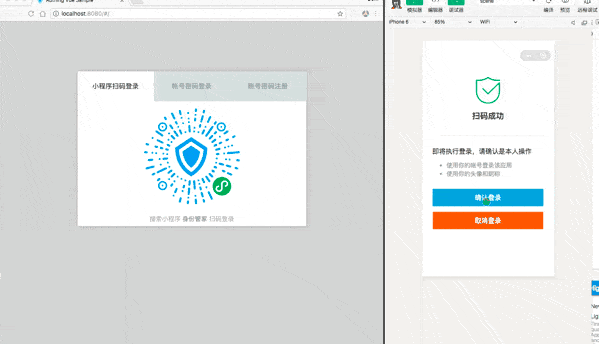Package Exports
- authing-js-sdk
This package does not declare an exports field, so the exports above have been automatically detected and optimized by JSPM instead. If any package subpath is missing, it is recommended to post an issue to the original package (authing-js-sdk) to support the "exports" field. If that is not possible, create a JSPM override to customize the exports field for this package.
Readme
authing.js
Authing 的 JavaScript SDK 支持 Angular.js, React.js, Vue.js 以及 Node.js.我们提供了完全一致的接口.

安装
NPM
当构建大规模应用时,我们推荐使用 npm 进行安装, 它可以与一些模块打包工具很好地配合使用,如 Webpack, Browserify。
# latest stable
$ npm install authing-js-sdk --save初始化
先从 Authing 控制台 中获取 Client ID。
为保证 secret 安全,在服务端的初始化和客户端的初始化有所不同。
服务端
服务端可直接传入 clientId 和 secret。
const auth = new Authing({
clientId: 'your_client_id',
secret: 'your_client_secret'
});
auth.then((authing) => {
// authing.login
// authing.register
// ...
});客户端
客户端需传入三个参数
- clientId
- 应用 ID,可从 Authing 控制台中获取。
- timestamp
- 当前时间戳
- nonce
- 一个随机数字,不要超过十位数
示例
const auth = new Authing({
clientId: 'your_client_id',
timestamp: Math.round(new Date() / 1000),
nonce: Math.ceil(Math.random() * Math.pow(10, 6)),
});
auth.then((authing) => {
// authing.login
// authing.register
// ...
});使用 accessToken
除了使用 clientId 和 secret 外,我们还支持传入 accessToken(需要 v1.5.0 版本及以上),示例如下:
const auth = new Authing({
accessToken: '71fc55de0fccba1b3f7feb68277e4f379a1019e5'
});
auth.then((authing) => {
// authing.login
// authing.register
// ...
});使用 accessToken 适用于 OAuth 场景,获取 accessToken 的方法请参考 OAuth 授权流程。
使用方法
Authing SDK 的所有 API 都支持 Promise。
const Authing = require('authing-js-sdk');
// 对 Client ID 和 Client Secret 进行验证,获取 Access Token
const auth = new Authing({
// 若在浏览器端请使用 timestamp + nonce + clientId 的形式
clientId: 'your_client_id',
secret: 'your_app_secret'
});
auth.then(function(authing) {
//验证成功后返回新的 authing-js-sdk 实例(authing),可以将此实例挂在全局
authing.login({
email: 'test@testmail.com',
password: 'testpassword'
}).then(function(user) {
console.log(user);
}).catch(function(error) {
console.log(error);
});
}).catch(function(error) {
//验证失败
console.log(error);
});
如果你使用 ES6+ 推荐用 await 处理异步,示例如下:
import Authing from 'authing-js-sdk';
const main = async () => {
//使用async时需要使用 try...catch... 捕捉错误
let auth;
try{
auth = await new Authing({
// 若在浏览器端请使用 timestamp + nonce + clientId 的形式
clientId: 'your_client_id',
secret: 'your_app_secret'
});
}catch(error) {
console.log('Authing 验证失败:', error);
}
if(auth) {
let user;
try {
user = await auth.login({
email: 'test@testmail.com',
password: 'testpassword'
});
}catch(error) {
console.log('登录失败:', error);
}
if(user) {
console.log('login success');
}else {
console.log('login failed');
}
}
}
main();
API
全部 API 请参考:用户接口。
小程序扫码登录
小程序扫码登录指使用 Authing 小程序 身份管家 执行微信登录。
示例:小程序扫码登录

基础用法
使用 startWXAppScaning 方法:
const Authing = require('authing-js-sdk');
const auth = new Authing({
clientId: 'your_client_id',
timestamp: Math.round(new Date() / 1000),
nonce: Math.ceil(Math.random() * Math.pow(10, 6)),
});
auth.then(function(authing) {
authing.startWXAppScaning({
mount: 'qrcode-node', //二维码挂载点的 HTML 元素 ID,如不写则默认漂浮在文档中间
});
})
扫码完成后会自动跳到用户配置的URL上。
参数说明
authing.startWXAppScaning({
mount: 'qrcode-node', // 二维码挂载点,如不写则默认漂浮在文档中间
redirect: true, // 是否执行跳转(在用户后台配置的 URL),默认为 true,相关用户信息回传至 url 上
onSuccess: function(res) {}, // 登录成功后回调函数,redirect 为 true 时不回调此函数
onError: function(error) {}, // 登录失败后回调函数,一般为网络问题
onIntervalStarting: function(intervalNum) {}, // 轮询时的回调函数,intervalNum 为 setInterval 返回的数值,可使用 clearInterval 停止轮询
interval: 1500, // 每隔多少秒检查一次,默认 1500
tips: '搜索小程序 <strong>身份管家</strong> 扫码登录', // 提示信息,可写 HTML
});
了解更多,请查看:使用小程序扫码登录
自定义请求链接
Authing 构造函数包含一个名为 host 对象,可接收自定义的请求链接(适合私有部署 Authing 的用户使用),使用方法如下:
const auth = new Authing({
clientId: 'xxxx',
secret: 'xxxxxx',
host: {
user: 'https://users.authing.cn/graphql',
oauth: 'https://oauth.authing.cn/graphql'
}
});
host 对象中 user 和 oauth 的默认值是 Authing 官方的请求链接:
Node.js其他生态中间件
当在浏览器使用时,我们会将用户 token 以 '_authing_token' 字段存在 localStorage 中,后面都会从 localStorage 中读取并进行验证。
了解更多报错的详情,请查看错误代码。
获取 Client ID 和 Client Secret,请点击这里。